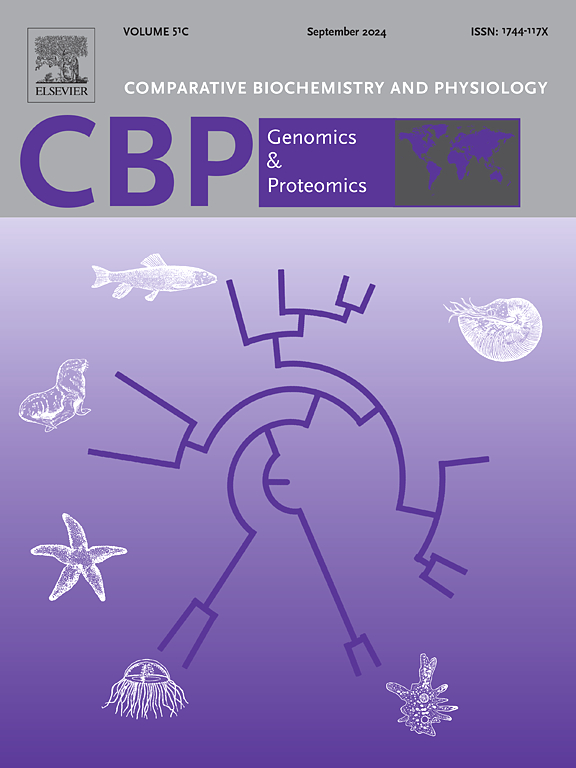螺旋藻替代鱼粉对感染嗜水气单胞菌的锯齿鳗肝脏的影响
IF 2.2
2区 生物学
Q4 BIOCHEMISTRY & MOLECULAR BIOLOGY
Comparative Biochemistry and Physiology D-Genomics & Proteomics
Pub Date : 2025-06-04
DOI:10.1016/j.cbd.2025.101563
引用次数: 0
摘要
随着经济的发展,人们对锯齿鳗(Mastacembelus armatus)等高价值鱼类的需求日益增加。然而,作为肉食性鱼类,为了节约养殖成本,需要在幼鱼期进行饵料训练,从而提高其养殖效率。然而,随着鱼粉价格的上涨和水体中有害细菌数量的增加,严重制约了黄颡鱼养殖的发展。因此,本试验在饲料过渡期间,采用不同比例的螺旋藻(0、5%、10%、15%、20%、25%)替代鱼粉饲喂黑斑沼虾幼苗。最后,用嗜水气单胞菌感染阿玛塔鼠,观察其对阿玛塔鼠免疫功能的影响。结果表明,桔梗能显著降低嗜水单胞菌对褐斑田鼠肝脏的损伤。通过提高T-SOD、GSH-px和T-AOC的活性,降低MDA的活性,提高了机体的抗氧化能力。转录组分析结果显示,白檀可激活肝脏糖酵解/糖异生和AMPK信号通路的激活。在糖酵解/糖异生途径中,gpi、pfkl和pfkp基因与其他基因的相关性最强。代谢组学结果表明,烟酸和烟酰胺代谢以及精氨酸和脯氨酸代谢途径被激活。综上所述,白僵菌能有效提高阿玛图鼠对嗜水单胞菌的感染耐受性。由此可见,银杏在促进肝脏代谢、增强机体免疫力方面具有很大的潜力,具有很大的应用价值。本文章由计算机程序翻译,如有差异,请以英文原文为准。

Effects of Spirulina platensis as a substitute for fishmeal on the liver of zig-zag eel (Mastacembelus armatus) infected with Aeromonas hydrophila
With the development of economy, there is an increasing demand for higher value fish such as Zig-zag eel (Mastacembelus armatus). However, M. armatus, as a carnivorous fish, needs to be trained to feed during the juvenile period in order to save the culture cost, so as to improve its culture efficiency. However, with the increasing price of fishmeal and the higher amount of harmful bacteria in the water body, the development of M. armatus aquaculture is seriously constrained. Therefore, in this experiment, different proportions of Spirulina platensis (0, 5 %,10 %, 15 %, 20 %, 25 %) were used to replace fishmeal and fed to M. armatus seedlings during the period of dietary transition. Finally, M. armatus was infected with Aeromonas hydrophila to investigate the effect of S. platensis on the immunity of M. armatus. The results showed that S. platensis significantly reduced the damage caused by A. hydrophila to the liver of M. armatus. S. platensis could improve the antioxidant capacity of the organism by increasing the activities of T-SOD, GSH-px and T-AOC, as well as decreasing the activity of MDA. The transcriptome showed that S. platensis could activate the hepatic activation of Glycolysis/Gluconeogenesis and AMPK signaling pathway. In the Glycolysis/Gluconeogenesis pathway, the gpi, pfkl and pfkp genes had the strongest correlation with other genes. Metabolomic results showed that S. platensis activates pathways such as Nicotinate and nicotinamide metabolism and Arginine and proline metabolism. In conclusion, S. platensis can effectively improve the infection tolerance of M. armatus against A. hydrophila. This suggests that S. platensis has great potential in promoting liver metabolism and boosting the body's immunity, which is of great value for application.
求助全文
通过发布文献求助,成功后即可免费获取论文全文。
去求助
来源期刊
CiteScore
5.10
自引率
3.30%
发文量
69
审稿时长
33 days
期刊介绍:
Comparative Biochemistry & Physiology (CBP) publishes papers in comparative, environmental and evolutionary physiology.
Part D: Genomics and Proteomics (CBPD), focuses on “omics” approaches to physiology, including comparative and functional genomics, metagenomics, transcriptomics, proteomics, metabolomics, and lipidomics. Most studies employ “omics” and/or system biology to test specific hypotheses about molecular and biochemical mechanisms underlying physiological responses to the environment. We encourage papers that address fundamental questions in comparative physiology and biochemistry rather than studies with a focus that is purely technical, methodological or descriptive in nature.

 求助内容:
求助内容: 应助结果提醒方式:
应助结果提醒方式:


